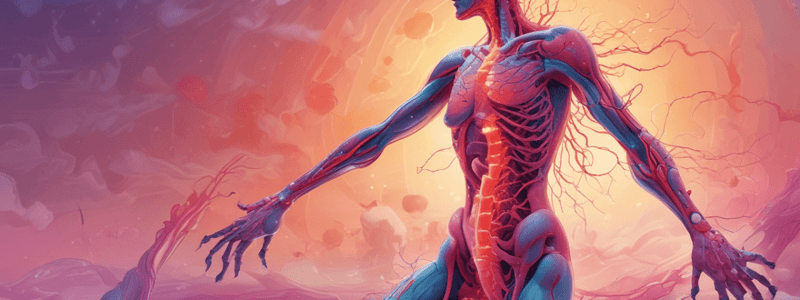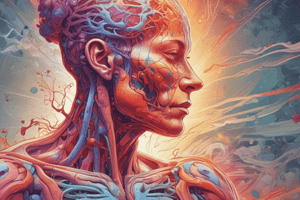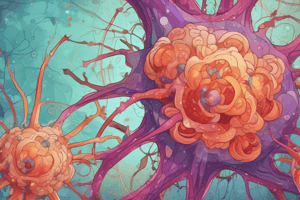Podcast
Questions and Answers
What is the term for the presence of microorganisms in the blood?
What is the term for the presence of microorganisms in the blood?
- Viraemia
- Bacteraemia
- Septicaemia (correct)
- Microbemia
What is the characteristic of Gram positive bacteria?
What is the characteristic of Gram positive bacteria?
- Thick layer of peptidoglycan (correct)
- Thin layer of peptidoglycan
- Outer membrane
- Lipopolysaccharides
What is the result of the release of endotoxins in the body?
What is the result of the release of endotoxins in the body?
- Vasodilation and decreased blood pressure (correct)
- Vasoconstriction and decreased blood pressure
- Vasoconstriction and increased blood pressure
- Vasodilation and increased blood pressure
What is the term for the process by which bacteria are classified based on their Gram staining?
What is the term for the process by which bacteria are classified based on their Gram staining?
What is the term for the ability of a microorganism to cause disease?
What is the term for the ability of a microorganism to cause disease?
What is the term for the ability of a microorganism to produce a toxin?
What is the term for the ability of a microorganism to produce a toxin?
What is the term for the presence of bacteria in the blood causing failure of the body's defence mechanisms?
What is the term for the presence of bacteria in the blood causing failure of the body's defence mechanisms?
What is the term for the process by which bacteria colonise and infect a host?
What is the term for the process by which bacteria colonise and infect a host?
What is the primary purpose of inflammation in response to tissue injury?
What is the primary purpose of inflammation in response to tissue injury?
What is the term for the movement of neutrophils and monocytes through the pores in blood capillaries to enter tissues?
What is the term for the movement of neutrophils and monocytes through the pores in blood capillaries to enter tissues?
What is the role of mast cells in the inflammatory response?
What is the role of mast cells in the inflammatory response?
What is the term for the process by which bacteria are made visible for neutrophils to be ingested?
What is the term for the process by which bacteria are made visible for neutrophils to be ingested?
What is the characteristic change in blood vessels during inflammation?
What is the characteristic change in blood vessels during inflammation?
What is the primary function of neutrophils in the inflammatory response?
What is the primary function of neutrophils in the inflammatory response?
What is the primary characteristic of obligate intracellular parasites?
What is the primary characteristic of obligate intracellular parasites?
What is the result of viral DNA entering the nucleus of a host cell?
What is the result of viral DNA entering the nucleus of a host cell?
What is the effect of viruses on host cell DNA, RNA, or protein synthesis?
What is the effect of viruses on host cell DNA, RNA, or protein synthesis?
What is the characteristic of fungi that invade the skin?
What is the characteristic of fungi that invade the skin?
What is the primary function of vaccines?
What is the primary function of vaccines?
What is the site where all immune cells are formed?
What is the site where all immune cells are formed?
What is the result of disruption of lysosomal membranes by viruses?
What is the result of disruption of lysosomal membranes by viruses?
What is the term for diseases caused by fungi?
What is the term for diseases caused by fungi?
Which type of immunity is present from birth and involves physical and chemical barriers?
Which type of immunity is present from birth and involves physical and chemical barriers?
What is the term for the overreaction of the immune system to environmental antigens?
What is the term for the overreaction of the immune system to environmental antigens?
Which type of cells are responsible for presenting antigens to T-cells?
Which type of cells are responsible for presenting antigens to T-cells?
What is the term for the breakdown of tolerance, causing the immune system to recognize self-antigens as foreign?
What is the term for the breakdown of tolerance, causing the immune system to recognize self-antigens as foreign?
Which type of immunity involves the action of B cells and antibodies?
Which type of immunity involves the action of B cells and antibodies?
What is the term for the inability of the immune system to protect the host against infections?
What is the term for the inability of the immune system to protect the host against infections?
Which type of cells are responsible for phagocytosis, the process of engulfing and destroying foreign particles?
Which type of cells are responsible for phagocytosis, the process of engulfing and destroying foreign particles?
What is the term for the proteins that are part of the innate immune response and help to eliminate pathogens?
What is the term for the proteins that are part of the innate immune response and help to eliminate pathogens?
What is the primary cause of Chronic Pyelonephritis?
What is the primary cause of Chronic Pyelonephritis?
What is the primary factor that affects the measurement of Glomerular Filtration Rate (GFR)?
What is the primary factor that affects the measurement of Glomerular Filtration Rate (GFR)?
What is the result of Silent stones causing obstruction in the urinary tract?
What is the result of Silent stones causing obstruction in the urinary tract?
What is the term for the clearance of a substance by the kidneys over a period of time?
What is the term for the clearance of a substance by the kidneys over a period of time?
What is the primary symptom of Urinary Tract Obstruction?
What is the primary symptom of Urinary Tract Obstruction?
Which of the following systemic diseases is a risk factor for Chronic Kidney Disease?
Which of the following systemic diseases is a risk factor for Chronic Kidney Disease?
What is the primary method of evaluation for Chronic Kidney Disease?
What is the primary method of evaluation for Chronic Kidney Disease?
Which of the following is NOT a management principle for Chronic Kidney Disease?
Which of the following is NOT a management principle for Chronic Kidney Disease?
What is the Cockcroft-Gault equation used to estimate?
What is the Cockcroft-Gault equation used to estimate?
Which of the following is a marker of kidney damage?
Which of the following is a marker of kidney damage?
What is the primary role of angiotensin-converting enzyme (ACE) inhibitors in the management of Chronic Kidney Disease?
What is the primary role of angiotensin-converting enzyme (ACE) inhibitors in the management of Chronic Kidney Disease?
What is the characteristic feature of Alzheimer's disease?
What is the characteristic feature of Alzheimer's disease?
What is the primary pathological feature of Alzheimer's disease?
What is the primary pathological feature of Alzheimer's disease?
What is the term for the gradual loss of memory, mood changes, and problems with communication and reasoning?
What is the term for the gradual loss of memory, mood changes, and problems with communication and reasoning?
What is the primary characteristic of Chronic Kidney Disease (CKD)?
What is the primary characteristic of Chronic Kidney Disease (CKD)?
What is the primary cause of Chronic Glomerulonephritis?
What is the primary cause of Chronic Glomerulonephritis?
What is the primary symptom of Acute Glomerulonephritis?
What is the primary symptom of Acute Glomerulonephritis?
What is the primary consequence of Urinary Tract Obstruction (UTO)?
What is the primary consequence of Urinary Tract Obstruction (UTO)?
What is the primary characteristic of Renal Tubular acidosis?
What is the primary characteristic of Renal Tubular acidosis?
What is the primary cause of Pyelonephritis?
What is the primary cause of Pyelonephritis?
What is the primary characteristic of Gross proteinuria?
What is the primary characteristic of Gross proteinuria?
What is the primary consequence of Chronic Glomerulonephritis?
What is the primary consequence of Chronic Glomerulonephritis?
Flashcards are hidden until you start studying
Study Notes
Inflammation
- Occurs in response to tissue injury to prevent and limit infection and further damage, and to initiate healing and adaptive immune response
- Characterized by localized vasodilation and increased capillary permeability, leading to movement of WBCs, complement, and plasma proteins to the site of injury
- 5 signs: heat, redness, swelling, pain, and loss of function
Mast Cells
- Cellular bags of granules located in loose connective tissue close to blood vessels, skin, digestive lining, and respiratory tract
- Activation: physical injury, chemical agents, immunologic processes
- Leads to degranulation and synthesis of lipid-derived chemical mediators
Phagocytosis
- Process by which cells ingest and dispose of foreign material
Neutrophils
- Most abundant white cells with a lifespan of 4-8 hours in circulation and 4-5 days in tissues
- Major defense against bacterial infection
- Diapedesis: neutrophils and monocytes squeeze through pores in blood capillaries to enter tissues, moving by amoeboid motion
- Chemotaxis: neutrophils move towards the source of certain chemicals (chemo-attractants)
Microorganisms
- Classes: bacteria, viruses, fungi, protozoa, parasitic worms
- Healthcare-acquired infections: direct, droplet, indirect, airborne/aerosol, vector-dependent, faecal-oral
Process of Infection
- Colonization, infection, spread
- Factors for infection: mechanism of action, infectivity, pathogenicity, virulence, immunogenicity, toxigenicity
Host Defenses
- Classes of infectious microorganisms: viruses, bacteria, fungi, protozoa, helminths
Bacteria
- Gram staining: distinguishes between gram-positive and gram-negative bacteria
- Bacterial toxins: exotoxins (enzymes released during bacterial growth) and endotoxins (lipopolysaccharides from outer membrane of dead gram-negatives)
Viral Replication
- DNA or RNA
- Protein receptor-binding site
- Viral DNA enters nucleus and is transcribed into mRNA
- Clinical symptoms reflect alteration of infected cell function
Cellular Effects of Viruses
- Inhibition of host cell DNA, RNA, or protein synthesis
- Disruption of lysosomal membranes
- Promotion of apoptosis
- Transformation of host cells into cancerous cells
Fungi
- Moulds or yeast
- Diseases caused by fungi are called mycoses
- Dermatophytes: fungi that invade the skin
Vaccines
- Induction of long-lasting protective immune responses
- Types: attenuated organism, killed/inactive organism, extracts of antigens, toxins
Immune System
- Lymphatic system: tonsils, thymus gland, lymph nodes, spleen, appendix
- Circulatory system: bone marrow, lymphocytes/white blood cells, phagocytic cells, dendritic cells, thrombocytes, complement proteins
Types of Immunity
- Non-specific (innate): present from birth, includes blood cells, physical barriers, chemical and mechanical barriers
- Specific (acquired/adaptive): develops in response to exposure to infectious organisms, includes humoral immunity (B cell-mediated) and cell-mediated immunity (T cell-mediated)
Urinary Tract Obstruction
- Urethral obstruction in men can lead to bacterial infection and increase the risk of prostatitis and prostatic hypertrophy.
- Urinary tract obstruction can also be caused by calculi or tumours.
- Renal calculi (stones in the urinary tract) are a common cause of upper urinary tract obstruction.
Chronic Kidney Disease (CKD)
- CKD is an irreversible loss of renal function that affects all organ systems.
- Can be caused by a variety of pathophysiological conditions, including systemic diseases (diabetes, hypertension) and renal diseases (chronic glomerulonephritis).
- CKD can lead to a decline in GFR (glomerular filtration rate) and tubular functions.
GFR
- Measurement of GFR is a good indicator of kidney function.
- GFR can be calculated by measuring the clearance of a substance by the kidneys over a period of time.
- Creatinine is a breakdown product of muscle that is normally cleared from the blood by the kidneys; increased levels in the blood indicate kidney dysfunction.
eGFR
- Estimated glomerular filtration rate is based on creatinine, age, body size, gender, and race.
Renal Failure
- Acute renal failure is a sudden, reversible decline in renal function.
- Chronic renal failure is a gradual, irreversible decline in renal function over time.
Glomerular Diseases
- Acute glomerulonephritis is characterized by large, inflamed glomeruli with decreased capillary lumen and rapid onset of haematuria and proteinuria.
- Chronic glomerulonephritis is characterized by glomerular scarring and eventual loss of functioning nephrons, leading to gradual development of uremia.
- Clinical manifestations of glomerulonephritis include hypertension, renal failure, haematuria, and proteinuria.
Tubular Diseases
- Tubular diseases result in decreased excretion/reabsorption of certain substances or reduced concentrating capability.
- Renal tubular acidosis is a disorder affecting acid-base balance.
Urinary Tract Infection
- Urinary tract infection is an inflammation of the urinary epithelium caused by bacteria from gut flora.
- Common pathogens include Escherichia coli and Staphylococcus saprophyticus.
Pyelonephritis
- Acute pyelonephritis is an acute infection of the renal pelvic, commonly caused by Escherichia coli and Proteus Mirabilis.
- Ascends from the lower urinary tract.
Evaluation of CKD
- Evaluation is based on risk factors, history, and presenting signs and symptoms.
- Elevated serum creatinine and serum urea concentrations are consistent with CKD.
- Markers of kidney damage include urine protein, albumin, and examination of urine sediment.
Management of CKD
- Dietary control, fluid evaluation, and restriction of sodium, potassium, and phosphate are important.
- Adequate kilojoule intake, management of dyslipidaemias, and iron, folic acid, and erythropoietin replacement therapy as needed are also important.
- Angiotensin-converting enzyme (ACE) inhibitors or receptor blockers are often used to provide renal protection and control systemic hypertension.
Alzheimer's Disease
- Alzheimer's disease is the most common type of dementia.
- The risk of developing Alzheimer's disease increases with age.
- Pathophysiological characteristics include death of pyramidal cells, neuritic plaques, and neurofibrillary tangles in the hippocampus, temporoparietal, and front cortices.
Dementia
- Dementia is a set of symptoms that include gradual loss of memory, mood change, and problems with communication and reasoning.
- Can lead to mood swings and violent outbursts.
Studying That Suits You
Use AI to generate personalized quizzes and flashcards to suit your learning preferences.




